Ladakh
Things to DO
Leh
Although there are a few indications that the Chinese knew of a trade route through Ladakh to India as early as the Kushan
period
(1st to 3rd centuries AD), and certainly by Tang dynasty (618-907 AD), little is actually known of the history of the region
before the formation of the kingdom towards the end of the 10th century by the Tibetan prince, Nyima Gon, a grandson of the
anti-Buddhist Tibetan king, Langdarma (reign 838-841). He conquered Western Tibet although his army originally numbered
only 300 men.
The first recorded royal residence in Ladakh, built at the top of the high Namgyal ("Victory") Peak overlooking the present
palace
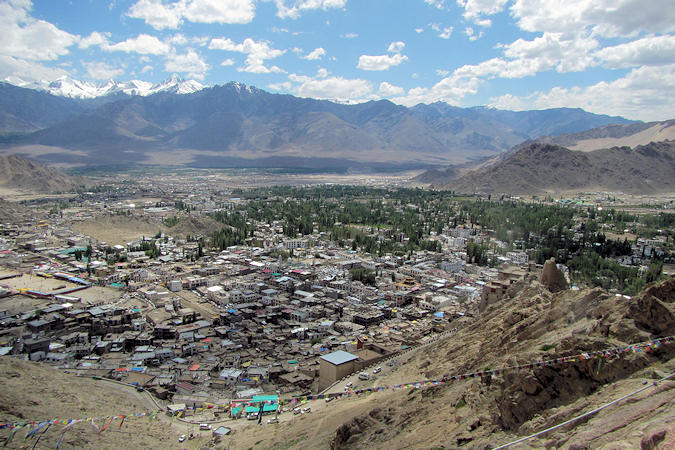 |
|||||
and town, is the now-ruined fort built by King Tashi Namgyal. Tashi Namgyal is known to have ruled during the final
quarter of the 16th century CE.
Directly beneath the fort lies the Namgyal Tsemo Gompa, built by king Gragspa Bum-lde, around the year 1430. One
of the most treasured possessions of the monastery is a three-story high solid gold idol of Maitrieya Buddha (future
Buddha, also known as the laughing Buddha).
The Leh Palace, was built by King Sengge Namgyal (1612–1642). The palace is nine storeys high; the upper floors
accommodated the royal family, and the stables and storerooms are located on the lower floors. The palace was occupied till the time of
Dogra invasion (1834-1842) after wich the royal family moved their premises south to their current home in Stok Palace on
the southern bank of the Indus.
During the reign of Deldan Namgyal (1642-1694), the "Nawab" of Kashmir, which was then a province in the Mughal Empire,
arranged for the Mongol army to temporarily leave Ladakh, though it returned later. As payment for assisting Delegs Namgyal in the
Tibet-Ladakh-Mughal War of 1679–1684, the Nawab made a number of onerous
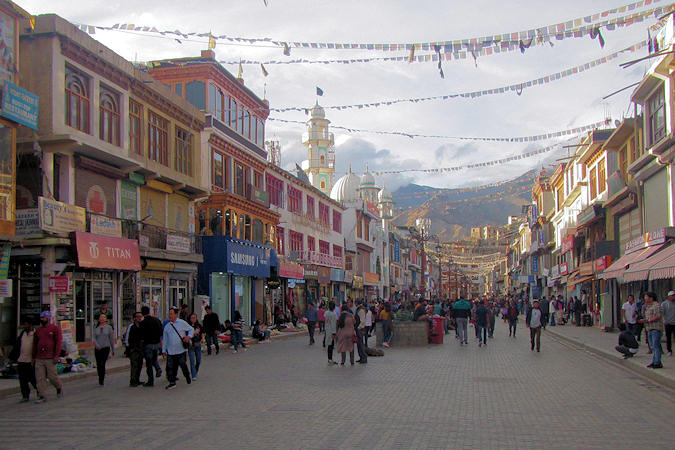 |
|||||
demands.
One of the least was to build a large mosque in Leh at the upper end of the bazaar in Leh, below the Leh Palace.
The Jamia Masjid reflects a mixture of Islamic and
Tibetan architecture and can accommodate more than 500 people. It was enlarged and rebuilt in 2018.
The Old Town bears testimony to the architectural heritage and socio-cultural history of Ladakh, which demonstrates an
indigenous aesthetic as well as links to Central Asia, Tibet and Kashmir. Within this area, lie several important historical buildings
including religious structures and Leh’s first cinema hall.
Shanti Stupa is located on the hilltop at Changspa. It can be reached quite easily from the Fort Road. The Stupa was constructed
by a Japanese Buddhist organization, known as "The Japanese for World Peace". The aim behind the construction of the stupa
was to commemorate 2500 years of Buddhism and to promote World Peace. His Holiness, the Dalai Lama inaugurated the Shanti Stupa in
the year 1985.
In Buddhism, a Kalachakra Stupa is a stupa whose symbolism is not connected to events in the Buddha's life, but instead to the
symbolism of the Kalachakra Tantra, created to protect against negative energies.
There are 8 different types of stupas in the sutras, all referring to important events in the Buddhas life. A ninth stupa, the
Kalachakra stupa, can be found among the highest teaching of the Buddha, also known as the “Wheel of Time”.
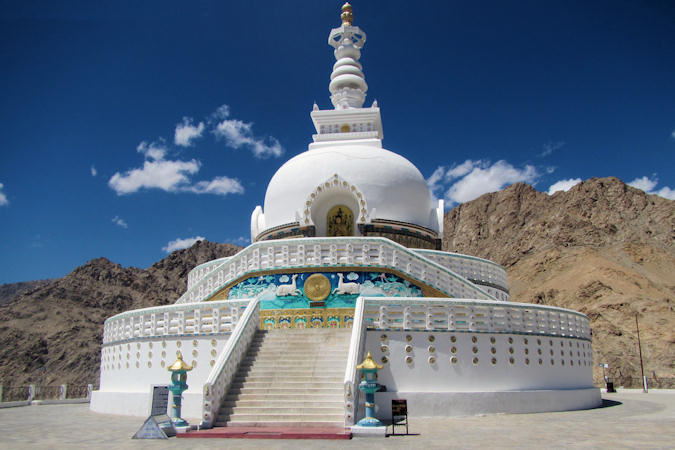 |
|||||
The Shey Monastery and the Shey Palace complex are structures located on a hillock in Shey, 15 kilometres to
the south of Leh.
The original palace, now in ruins, was built by Lhachen Palgyigon, the king of Ladakh, in the 10th century. The Moghul noble
Mirza Haidar Dughlat stayed here during his invasion of Ladakh in the 16th century.
The current Shey Palace and Monastery were built in 1655 on the instructions of Deldan Namgyal, in the memory of his late
father, Sengge Namgyal, below the first palace. When the Dogras of Jammu invaded Ladakh in 1842, the Namgyals abandoned the
palace and fled to Stok on the opposite side of the Indus River.
The monastery is noted for its giant copper with gilded gold statue of a seated Shakyamuni Buddha.
Around 200m back towards Leh from the palace approach lane are rock carvings of the Five Tathāgatas,
distinguished by their respective vehicles ("vahanas") and hand position ("mudras") The large central figure with hands
held in the gesture of preaching (turning the wheel of Dharma), is the Buddha resplendant Vairocana.
Monasteries around Leh
In the monasteries and villages of the Ladakh region, Buddhist lamas (priests) chant sacred texts representing the spirit, philosophy
and teachings of the Buddha.
The monasteries around Leh belong to three of the major schools of Tibetan Buddhism, namely
Nyingma (c. 8th century), Kagyu (11th century), and Gelug (1409).
1) Nyingma
The Nyingma school is the oldest of the four major schools of Tibetan Buddhism, founded by Vajrayana revealer Guru
Padmasambhava ("Born from a Lotus"), who Tibetans call Guru Rinpoche.
"Nyingma" literally means "ancient", and is often referred to as "school of the ancient translations" or "old
school". The Nyingma school is founded on the first translations of Buddhist scriptures from Sanskrit into Old Tibetan in the
eighth century, during the reign of King Trisong Detsen. The Tibetan alphabet and grammar was created for this endeavour.
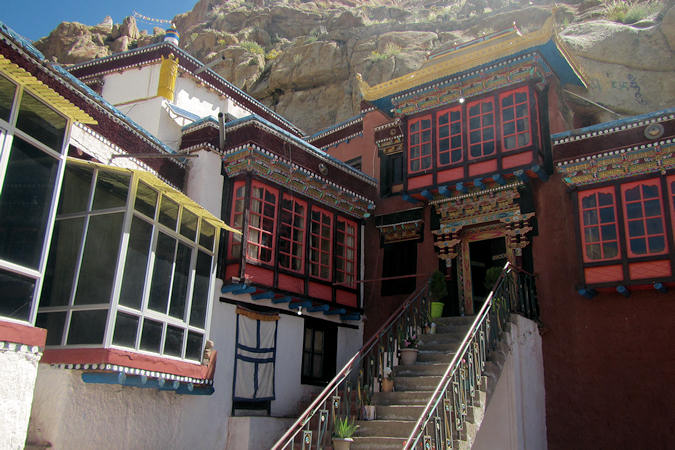 |
|||||
Takthok Monastery is situated in Sakti Village, at a distance of approximately 46 km from the town of Leh.
The name Takthok literally means "rock-roof". The monastery was so named, as both its roof as well as walls are made up of rock.
It is the only Nyingma monastery in Ladakh and approximately 55 lamas reside there.
To the left of the central courtyard is the cave chapel of the monastery, believed to the place where Padmasambhava lived and
meditated for three years.
On the right of the central courtyard, lies the "Dukhang" or the main assembly hall. There is a throne inside the Dukhang,
reserved solely for the Dalai Lama. The wall to the left of the throne stands decorated with the mural of Padmasambhava, while the
one on the right has a painting of Sakyamuni.
Also inside the Dukhang, are the statues of Maitreya (the Future Buddha or Buddha of Compassion), Padmasambhava and
Dorje Takposal (a manifestation of Padmasambhava).
2) Kagyu
The Kagyu school, which translates to "Oral Lineage" or "Whispered Transmission" trace themselves back to the
11th century Indian mahasiddhas Nāropā, Maitripa and the yogini Niguma, via their student Marpa Lotsawa
(1012–1097), who brought their teachings to Tibet. Marpa's student Milarepa was also an influential poet and teacher.
The Tibetan Kagyu tradition gave rise to a large number of independent sub-schools and lineages. The principal Kagyu lineages existing
today as independent schools are those which stem from Milarepa's disciple, Gampopa Sönam Rinchen (1079–1153), a monk who merged the Kagyu
lineage with the Kadam tradition.
2a) Drikung Kagyu
The founder of the Drikung Kagyu lineage was Jigten Sumgön (1143-1217) of the Kyura clan, who was the disciple of Phagmo Drupa Dorje Gyalpo (1110-1170) one of the three main disciples of Gampopa.
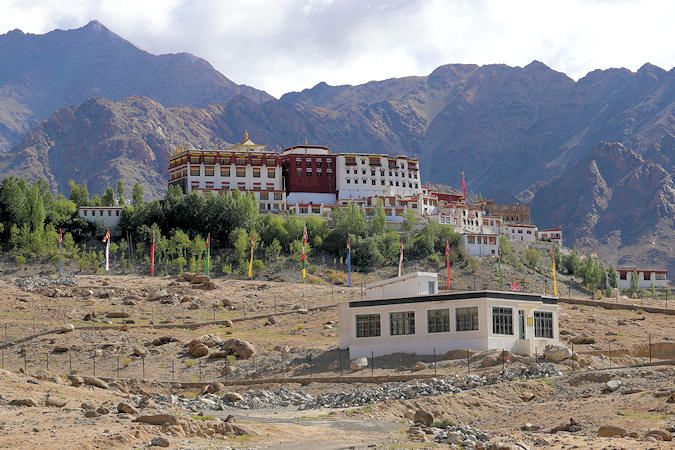 |
|||||
Situated at a distance of approximately 40 km to the west of the Leh Phyang Monastery is one of the only two monasteries
in Ladakh belonging to the Drikung Kagyu sect, the other being the Lamayuru Monastery.
There are a number of sacred shrines situated inside the monastery complex. Also, there are some exquisite wall paintings,
dating from the royal period, adorning the monastery.
The name Phyang was derived from Gang Ngonpo that means the blue mountain, which is situated behind the monastery.
The monastery was founded by Denma Kunga Drakpa who had camped in this area in the early 16th century. While meditating,
he had a vision of protectress Achi riding her blue horse, and took the dream as an auspicious sign to construct a monastery on
that spot. And thus Phyang Monastery was built.
Lamayuru Monastery is lies at a distance of about 127 km to the west of Leh town and houses approximately
150 Buddhist monks.
The monastery has a "Dukhang", (assembly hall); "Singhe Ghang" (temple); "Gonkhang" and residential places for
monks. On entering the temple, you see a life-size image of Vairochana Buddha and the Gonkhang is dedicated to Guardians
of Buddhism.
Ancient legends say that at the time of Sakyamuni (the Historical
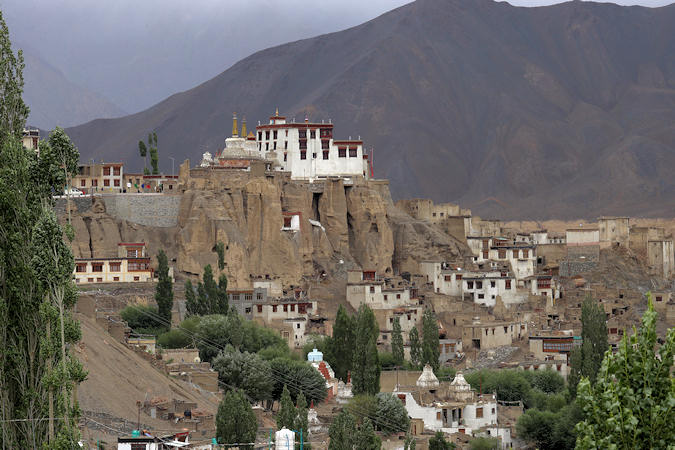 |
|||||
Buddha), Lamayuru's valley was a clear lake where "nagas" (holy serpents) lived. The bodhisattva Madhyantaka
foretold that the lake would be emptied and a monastery built there. The legends continue by saying that Nāropā, an
11th century Indian Buddhist Mahasiddha, came to Lamayuru and spent many years meditating in a cave, which can still be seen in the
main Dukhang. Nāropā then caused a split in the surrounding hillside and the lake emptied through this opening. After the lake
emptied, Nāropā found a dead lion previously covered by the waters of the lake. On this spot, Nāropā built the first temple at
Lamayuru, the "Singhe Ghang" (Lion Mound).
Other historical accounts relate that in the 10th century the King of Ladakh ordered the building of Lamayuru gompa and
placed it under the supervision of Rinchen Zangbo (958-1055 AD). After this, the monastery came under the administration of
the Zhwa-mar-pa (Red Hats).
In the 16th century, Ladakh's King Jamyang Namgyal was cured of leprosy by a lama from Tibet. In gratitude, the King gave
Lamayuru gompa to this lama and this led to the observance of the rituals of the Drikung Kagyu School.
2b) Drukpa Lineage
The Drukpa lineage was founded in west Tibet by Tsangpa Gyare (1161–1211), a student of Ling Repa, who mastered the
Vajrayana practices of the mahamudra and "Six Yogas of Nāropā" at an early age. Ling Repa (1128-1188) was a disciple of
Phagmo Drupa Dorje Gyalpo (1110-1170). As a tertön or "finder of spiritual relics", Tsangpa Gyare discovered the text of the
"Six Equal Tastes", previously hidden by Rechung Dorje Drakpa, the student of Milarepa.
While on a pilgrimage Tsangpa Gyare and his disciples witnessed a set of nine dragons (Tibetan: "druk") roaring out of the
earth and into the skies, as flowers rained down everywhere. From this incident they named their sect Drukpa.
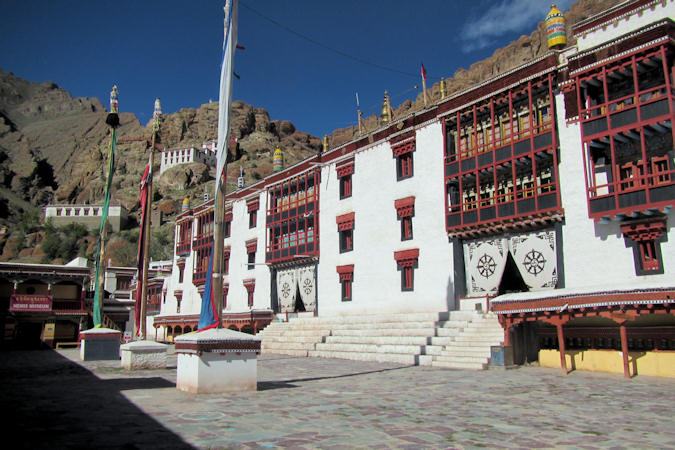 |
|||||
Hemis Monastery holds the distinction of being the biggest as well as the wealthiest monastery of Ladakh and is positioned
inside a gorge, at a distance of 47 km from Leh. It dates back to the year 1630 and was founded by Stagsang Raspa.
The array of items kept inside the monastery consist of a copper-gilt statue of the Lord Buddha, various gold and silver stupas,
sacred thankas and several other exquisite objects.
Chemrey Monastery is situated at a distance of approximately 40 km to the east of the town of Leh. It was founded in 1664
by the Lama Tagsang Raschen and dedicated to King Sengge Namgyal.
The monastery comprises a number of shrines, two assembly halls and a Lama temple. The main attraction of the monastery is the
one storey high statue of Padmasambhava. Another big attraction is the 29 volume scripture written in silver and golden letters.
Stakna Monastery is situated on the left bank of the Indus River, at a distance of 25 km from the town of Leh and serves as
the residence of approximately 30 monks.
The name, "Stakna" literally means
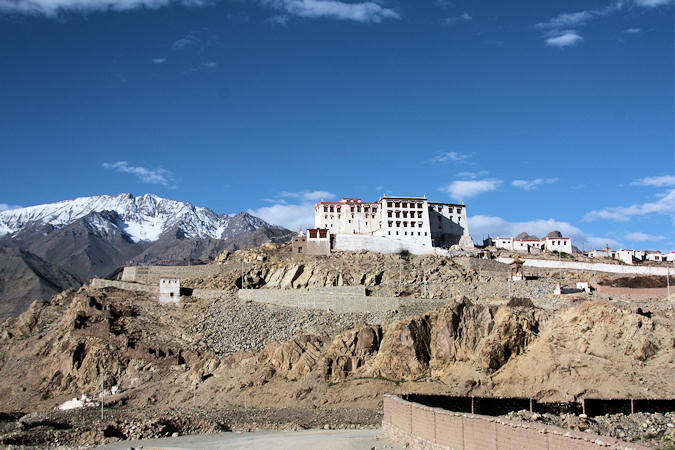 |
|||||
"tiger's nose". The monastery was so named because it was built on a hill, which is shaped just like a tiger's nose.
Stakna Monastery owes its inception to Chosje Jamyang Palkar, the great scholar saint of Bhutan. It formed a part of
the many religious estates offered by the king Jamyang Namgial to the saint, around 1580 AD.
On entering the central courtyard, one comes across the Dukhang (main assembly hall). To the right of the hall are the statues
of Sakyamuni (Past Buddha), the Present Buddha and Maitreya (Future Buddha).
The dukhang also holds a statue of Ngawang Namgyal (later granted the honorific "Zhabdrung Rinpoche", approximately
"at whose feet one submits" (1594–1651) and known colloquially as The Bearded Lama.
He was a Tibetan Buddhist lama and the unifier of Bhutan as a nation-state. In addition to unifying the various warring chiefdoms
for the first time in the 1630s, he also sought to create a distinct Bhutanese cultural identity separate from the Tibetan culture
from which it was derived.
Geluk
The Gelug (meaning "virtuous") is the newest and currently most dominant school of Tibetan Buddhism. It was founded by
Je Tsongkhapa (1357–1419), a Tibetan philosopher, tantric yogi and lama.
The Gelug school is alteratively known as New Kadam, since it sees itself as a continuation of the Kadam tradition of Atiśa
(982-1054). Furthermore, it is also called the Ganden school, after the first monastery established by Tsongkhapa.
The Ganden Tripa is the nominal head of the school, though its most influential figure is the Dalai Lama.
Allying themselves with the Mongol Khans, the Gelug school emerged as the pre-eminent Buddhist school in Tibet and Mongolia since
the end of the 16th century. Another alternative name for this tradition is the "Yellow Hat" school.
Thikse Monastery is located on top of a hill in Thiksey approximately 19 kilometres east of Leh.
In the early 15th century, Je Tsongkhapa, sent six of his disciples to remote regions of Tibet to spread the teachings of the
new school. Tsongkhapa gave one of his disciples, Jangsem Sherap Zangpo, a small statue of Amitābha (one of the
Five Tathagata), containing bone powder and a drop of Tsongkhapa's own blood. Tsongkhapa directed him to meet the King of Ladakh
with a message seeking his help in the propagation of Buddhism.
The King, loved the gift of the statue. and directed his minister to help Sherab Zangpo to establish a monastery of the Gelug order
in Ladakh. As a result, in 1433, Zangpo founded a small village monastery called Lhakhang Serpo "Yellow Temple" in Stagmo,
north of the Indus. In spite of his efforts, the lamas who embraced the Gelug order were initially few.
In the mid 15th century, Palden Zangpo continued the monastic work started by his teacher, Sherab Zangpo. He decided to build
a
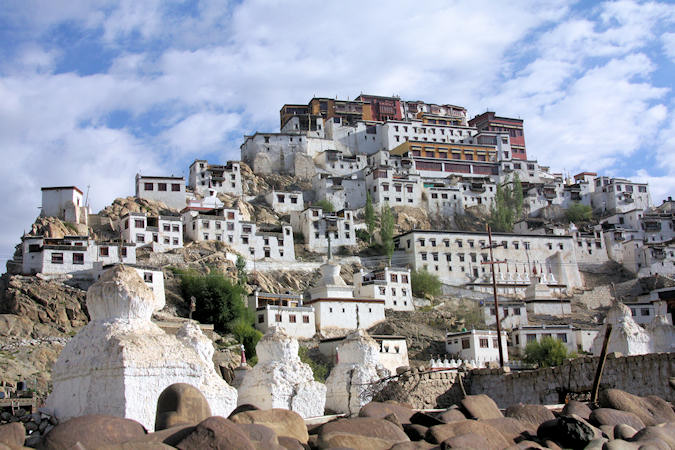 |
|||||
larger monastery here that was dictated by an unusual event that occurred while choosing a site.
According to legend, Sherab Zangpo and Palden Zangpo were performing some sacred rituals with a ritual cake near the Yellow Temple.
A crow flew away with the cake. When they searched, they found the ritual cake in perfect order at the top of the hilltop. They
believed it was an auspicious sign to build a monastery at this place. The monastery got the name Thiksey (meaning "in perfect
order") as the cake was put in a perfect order by the crow.
Thiksey grew in prominence in Ladakh, second only to Hemis Monastery, administering ten other monasteries in the region, such as
Spituk, Likir and Diskit.
The monastery has a courtyard from where a flight of steps leads to the main monastery (one of the 10 temples here), which is 12
stories in height. The centre of the "Dukhang" has a seat for the Dalai Lama and to its right, for the head lama and to its
left, another deity is pictured. Also, a "Gonkhang", devoted to several guardian divinities can also be seen between the main
courtyard and the staircase.
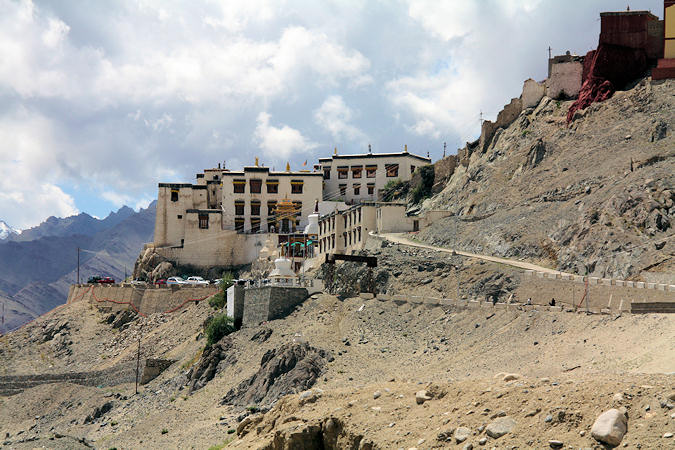 |
|||||
Spituk Monastery, is located at a distance of 8 km from the town of Leh and is home to about 100 monks.
It was founded by Od-de, the elder brother of Lha Lama Changchub Od when he came to Ladakh in the 11th Century. When
lotsawa Rinchen Zangpo called the "Translator" (958–1055) came to that place he said that an exemplary religious
community would arise there and so the monastery was called spituk ("exemplary"). At that point of time, the Spitok Monastery
was under the Kadam School.
During the 15th century under the reign king Gragspa Bum-Ide the monastery was restored by Lama Lhawang Lodos and the
stainless order of Tsonkhapa was introduced and it has remained intact as such till present.
The "Dukhang" has ancient collection of thangkas, masks and antique arms. There is a big throne in the assembly hall for
the Dalai Lama.
Diagonally opposite the dukhang and on the same level is a small temple called "Dolma Lokhang" which is devoted to
Tara (Dolma in Ladakhi) the consort of Avalokiteśvara. It has 21 beautiful statues of Tara, representing her different forms.
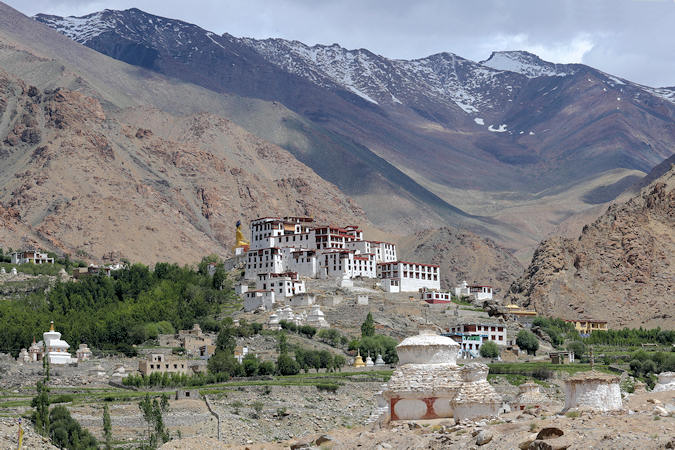 |
|||||
Likir Monastery is located at 3700 m elevation, about 52 kilometres in the west of Leh and serves as the residence
of 120 Buddhist monks. The monastery also has a school, in which almost thirty students study.
Likir means "The Naga encircled". The monastery got its name as it is believed two serpent spirits – Nanda and Taksako – guard
it.
The monastery was established in 1065 by Lama Duwang Chosje under the command of Lhachen Gyalpo, the fifth King of
Ladakh and originally belonged to the early Kadampa order of Tibetan Buddhism.
In the 15th century, Likir Gompa came under the influence of Lodos Sangphu, who converted the lamas to the reformed doctrines
of the Gelugpa order.
Besides being one of the oldest monasteries of Ladakh, Likir also has the distinction of being one of the wealthiest monasteries
in Ladakh as well. The main attractions of the monastery are its architecture, murals, thangkas, 23 m statue of Buddha on
the roof and stupas. The main image in the "Dukhang" is that of Avalokiteśvara, with 1000 arms and 11 heads.
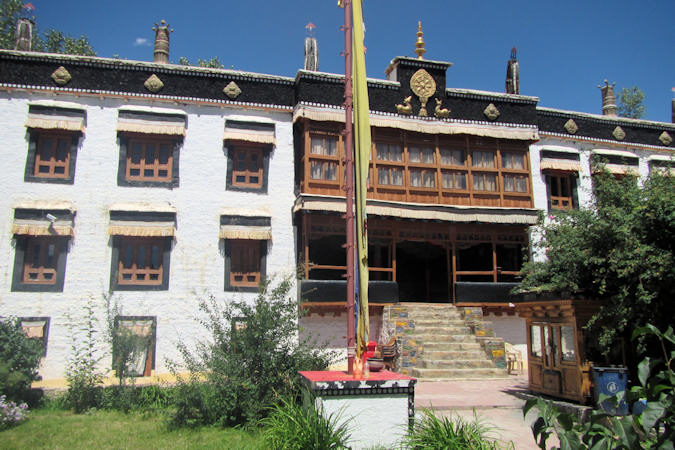 |
|||||
Sankar Gompa is a Buddhist monastery within an easy half-hour walk from Leh. Only 20 monks at most live here, and only a few
permanently, so visiting hours are limited to early morning and evening.
To the right of the front yard of the monastery is the "Dukhang" (assembly hall). Both the sides of its entrance are adorned
with the paintings of the "Four Heavenly Kings".
Rizong Monastery is situated at a distance of approximately 73 km from the Leh town and serves as the residence of
40 monks. It was established in 1831 by Lama Tsultim Nima under the Gelukpa order and is also called "the paradise for
meditation" and is noted for its extremely strict rules and standards.
The nunnery, located about 2 km from the monastery, is called the "Jelichun Nunnery", where, at present, 20 nuns reside.